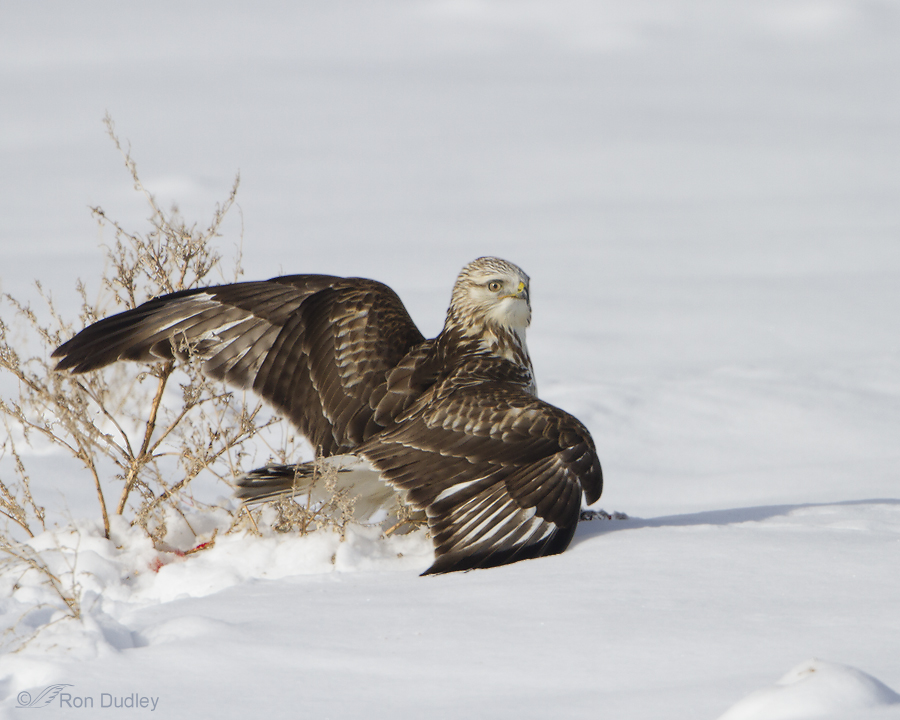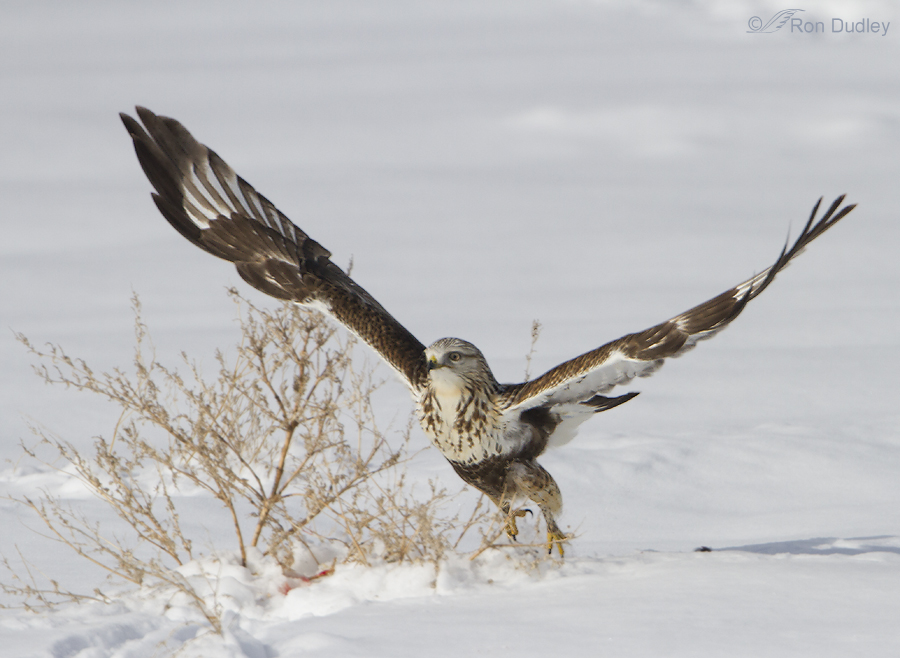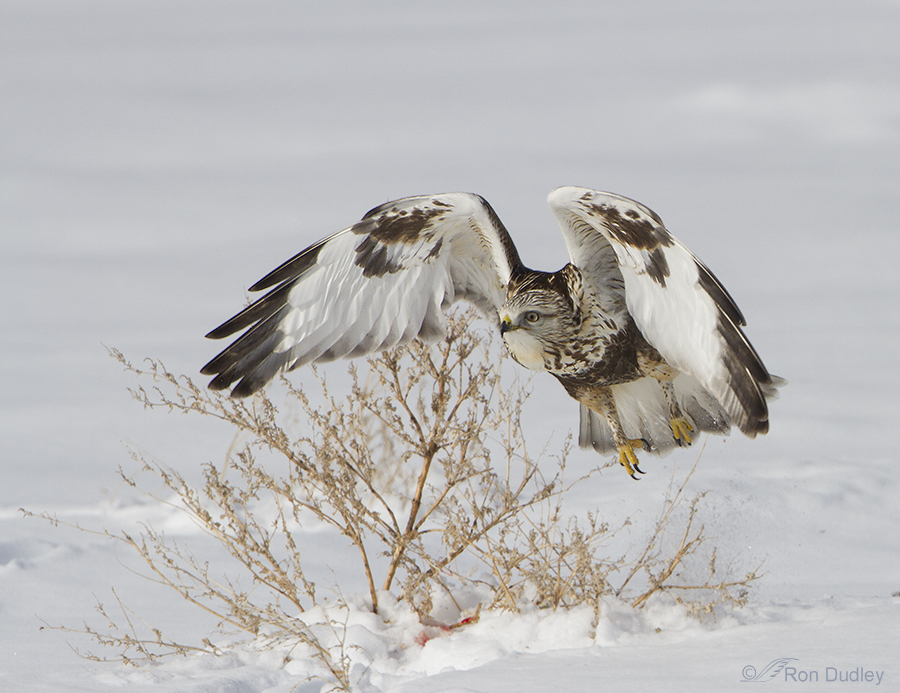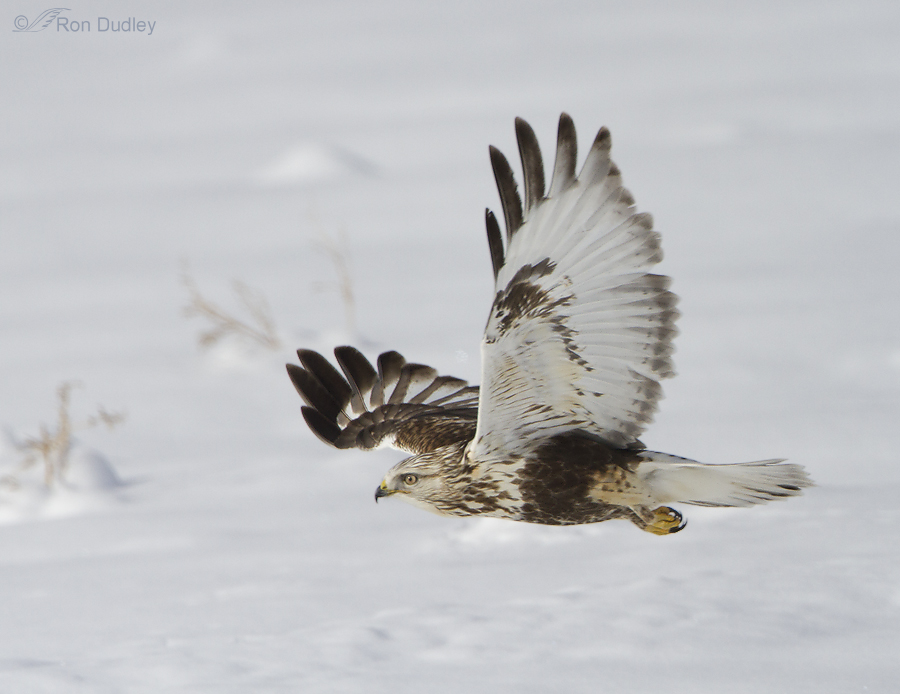My encounter with this Rough-legged Hawk was a frustrating one. It all began with a Northern Harrier on the snow-covered ground with prey (which turned out to be a Pied-billed Grebe) . It was quite far away, even if my tc had been attached (it wasn’t), so I put my pickup in gear to drive further down the road. Just then this hawk swooped in from behind (I couldn’t see it coming) to pilfer the prey from the harrier.
By the time I got the pickup turned off and my tc attached the action between the two raptors was over – the harrier had vamoosed with the head of the grebe (based on the photos Mia was able to get) and the roughie was on the ground with what was left.

1/3200, f/6.3, ISO 500, 500 f/4, 1.4 tc, natural light, not baited, set up or called in
Here the hawk is “mantling” the grebe. Mantling is a behavior of raptors where they spread their wings, fan their tail and arch their body over their prey – effectively hiding it from other predators, particularly other raptors. In this image the tail isn’t completely fanned and the bird is looking back at us rather than arching its body. There’s a patch of blood on the snow and you can see part of the grebe under the right wing.

1/5000, f/6.3, ISO 500, 500 f/4, 1.4 tc, natural light, not baited, set up or called in
The hawk quickly gobbled down what was left of the grebe, inspected the area for a few seconds to make sure it hadn’t missed any tasty morsels and then took off.

1/5000, f/6.3, ISO 500, 500 f/4, 1.4 tc, natural light, not baited, set up or called in
I took quite a few photos as the bird launched and flew to my left but only a few of them were relatively sharp with no clipped body parts.

1/5000, f/6.3, ISO 500, 500 f/4, 1.4 tc, natural light, not baited, set up or called in
This was the last decent image I got before the bird was too far past me.
I love the combination of my 500 mm lens attached to the tc for the extra reach it gives me (I’m effectively shooting at 1120 mm with the cropped sensor of my Canon 7D) but there’s definitely a down side. Even though I’ve become pretty quick and efficient at swapping out the tc, occasionally I do miss some very interesting shots while I’m doing it.
It seems like there’s always trade-offs…
Ron


Ron: what is exactly mantling behaviour? I know what mantle feathers are as anatomical parts, but I’ve also heard “mantling” from another photographer before. What is it exactly?
Maria, I’m not sure I can explain mantling any better than I did in the text under the first image so here’s a link that might do a better job of it. The word comes from old English/Norse for “cloak”. http://birding.about.com/od/birdingglossary/g/Mantling.htm
Great explanation from that link. I’ve seen this behaviour before but now I can correctly use the term.
Dear Mr. Dudley,
I can’t believe that I lived what I had formerly believed to have been a full life of 68 years without seeing your drop dead amazing pictures. I had no idea it was possible to take pictures such as you do and I am sincerely thrilled to see these breathtaking hawks making their magnificant moves. I originally stumbled upon your website while seeking to identify the rough legged hawk I saw on the ground with prey here in Bucks County, Pennsylvania. It was the first time I had ever seen what I would describe as a beautiful hawk but now I’m seeing them whenever I wish to thanks to your generosity in sharing them on your website and in your fabulous emails. Honestly, it has been like Christmas for me every day. Thank you so very, very much you wonderful teacher, photographer, nature lover, scientist and gentle man.
Sincerely yours,
Janice Webb, No. 1 Fan
Hi Janice, (please call me Ron) – I’m sure I don’t deserve all the high praise but I thank you for it anyway. And yes, many folks believe the Rough-legged Hawk to be the most handsome of all the North American Raptors, an opinion I would not dispute. I’m delighted that you enjoy my posts and hope that continues.
In such a cold winter as you are having, the Harrier was definitely robbed. I love the Roughie though, and these shots are superb. Thank you.
Thank you, Elephant’s Child.
These are exquisitely beautiful–if I had taken even one such beautiful photo, I’d be over the moon. In spite of the fact that these hawks are consummate predators, I find them to be incredibly sweet looking. This is especially true in a few of the photos you feature in your banner (like the one flying from right to left with both wings up and the head lifted).
Thanks very much, Sharon. And speaking of my banner (header images) some may have noticed lately that the header images have been off-center and cut off on the right. There’s been a glich in the theme I’m using for this blog and the author of the theme is no longer supporting it so I’m beginning the process of making new header images. Might take me a while though…
Good shots to help me better understand bird anatomy. I never new how Box like the body of hawks appear to be. In your photos many times at take off or in fast turns the body takes on this box rectangle shape . It reminds me of modern jet fuselage shapes . In field guide drawings of birds, and older not so good photos we never see this . This helps me to draw and paint birds with better accent on there powerful attributes. A lot of bird painters tend to make them round and too soft instead of muscular and a little scary.
Eldridge, I think that “box-like” appearance of the body, at certain angles, can be partially due to a full crop – as in this case. Then there are species like the Ferruginous that are barrel-chested in the first place. I like getting your artistic perspective on these birds and my images in general.
What beautiful coloring on this “Roughie ” ! Being from the east coast I’ve never been able to see on of these hawks up close,especially in the Mantling mode. Thank you Ron for all the pains you take to present your work.
John, I’ve seen this species do it a couple of times before but never was able to get any decent shots of it.
Love these images, Ron, especially that third one. A wonderful pose. I still haven’t been able to swap the TC very speedily, when I am in the cramped up front seat of my car. But like you say, the trade-offs…….
Bob, I have to do the “swap” thing so often that even I improved at it over time…